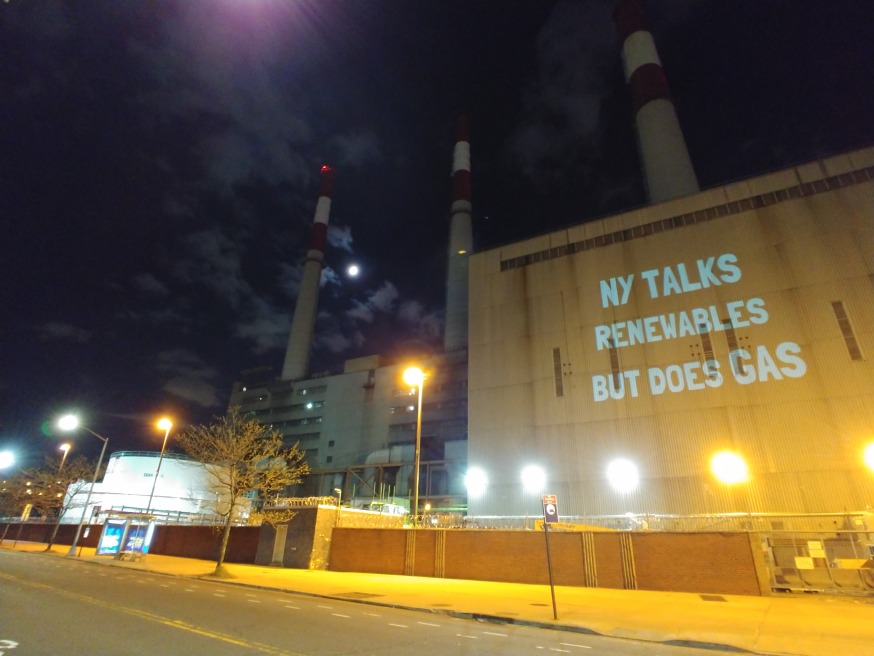
Activists of Nuclear New York project messages onto Ravenswood Generating Station in Queens during Earth Day last week. (Photo by Dietmar Detering)
April 30, 2021 Op-ed by Dietmar Detering
The decision to close Indian Point, the nuclear plant located 35 miles north of NYC, is wrongheaded, and will result in more pollution for residents of western Queens—setting New York back decades on climate action.
One might think that with passage of New York State’s celebrated Climate Leadership and Community Protection Act (CLCPA) in late 2019, polluting power plants like Ravenswood and Astoria generating stations in Queens would soon be retired.
After all, the CLCPA requires decarbonization of our grid and champions environmental justice. Instead, however, the state is shutting down its largest source of carbon-free energy and burning more fracked gas:
In 2017, Governor Cuomo, with the support of Riverkeeper and other big green groups, strong-armed Entergy to prematurely close the Indian Point nuclear energy plant, located north of our city on the Hudson River.
The first of the two reactors on-site was shuttered last year; the other will close tonight. Doing so will wipe out 16.7 terawatt-hours of annual carbon-free electricity from New York’s grid. That’s 2.5 times the energy generated by every solar panel and wind turbine throughout the state.
Fossil fuels will swell to 90 percent of all downstate generation. According to Riverkeeper and some state officials, renewables and energy efficiency are replacing Indian Point. However, real-time records from New York’s Independent System Operation (NYISO) prove this to be false. Gas use jumped after the first reactor shut down, despite a pandemic-induced reduction in demand.
This should come as no surprise considering that two massive new fracked gas plants were built specifically for this purpose: CPV Valley and Cricket Valley Energy.
In fact, Cricket Valley fired up last March, just days before the first Indian Point reactor shut down. When the last reactor closes, old fossil fuel plants in densely populated metro areas, especially Queens, may need to ramp up too.
The CLCPA is supposed to cut emissions, move the state to carbon-free electricity by 2040, and protect public health. But in year one of the law, New York lurched backwards on each of these goals.
Residents of Astoria and Long Island City already know first-hand why their communities are labeled “Asthma Alley.” Closing Indian Point means that they will have to suffer longer. Moreover, the planet will have to wait longer for New York’s greenhouse gas emissions to go down.
Riverkeeper’s nonsensical drumbeat of radiation, melt-downs, and terrorist threats simply do not match the reality of safe, reliable electricity generation by Indian Point for decades.
In fact, the facility’s remaining reactor just achieved a 752-day world record for longest continuous operation. Other plants of similar caliber in the U.S. have obtained approvals to operate for decades more. Removing Indian Point from service is a travesty.
CLCPA’s first disastrous year shows that New York cannot afford to make the same mistake again.
California has built six times the solar and wind capacity of New York, and Germany has spent a half trillion Euros on renewables. Yet both remain inextricably tied to fossil fuels because they decided to shun carbon-free nuclear power. Will New York follow in their failing footsteps by sacrificing the state’s remaining nuclear fleet?
Whether disingenuous or profoundly naïve, the reckless demand for “100 percent renewables” and demonization of nuclear power has brought more fracked gas to New York. Meanwhile, the fossil fuel industry is laughing all the way to the bank.
Dietmar Detering lives with his family in Sunnyside. He is part of Nuclear New York (www.NuclearNY.org), which unites environmentalists from across the state to advocate for nuclear energy as a key technology to protect climate, nature, and air quality. Nuclear New York is a project of Community Studies of NY, Inc, a 501(c)3 charity and is funded by contributions from individuals.
3 Comments

Well written piece with real facts. Too bad pandering politicians ignore facts whenever convenient.
I am quite happy that this danger of a nuclear accident, so close to us, will be gone at the end of today.
Jenastoriat: I am sorry you have been taught to live in fear of a plant that has harmed no one and provided so much electricity in the safest way we know of. Instead, you seem to feel just fine living around polluting, gas- and oil-burning plants that produce only a fraction of Indian Point’s output, yet sicken and kill your neighbors year after year and stand to benefit from Indian Point’s closure.